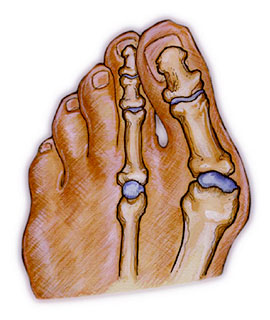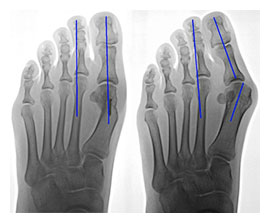Bunion
 (“Hallux Valgus”)
(“Hallux Valgus”)
What is it?
A bunion is a medial deviation and inflammation of the metatarsophalangeal (MTP) joint of the big toe. The capsule of the joint is subluxed (displaced), thickened and enlarged, and the cartilage of the joint is damaged. There are three degrees of bunions: mild, moderate and severe. Bunions are not hereditary, although the tendency to over-pronate, which is the cause of bunions, has a hereditary component.
What are the common symptoms/complaints?
Patients complain of pain in the MTP joint and have a deformed (medially deviated) big toe. Often, they are only able to wear very wide shoes.
How is it caused?
Prolonged pressure against the medial aspect of the first MTP joint can lead to thickening of the medial capsule and bursa, resulting in severe valgus deformity of the great toe. Normally “toe-off” occurs from the plantar surface of the big toe. Over-pronation can cause the propulsion phase of stance to take off from the medial aspect of the phalanges of the big toe instead of the plantar surface. As a result, there is a retrograde force into the joint which pushes it out medially and stretches the joint capsule. This tearing and stretching of the joint capsule as well as the wear and tear on the cartilage causes the pain.
How is it treated?
 Since the problem is the over-pronation, bunion treatment would include the patient being fitted with orthotics; one can expect a slow recovery over a period of months. Orthotics will not cause the physical deformity to regress, but will simply arrest any further progression and likely stop the pain.
Since the problem is the over-pronation, bunion treatment would include the patient being fitted with orthotics; one can expect a slow recovery over a period of months. Orthotics will not cause the physical deformity to regress, but will simply arrest any further progression and likely stop the pain.
It is important to note however, that when bunions are severe and require surgery, the bunion can be corrected, but will develop again unless the root cause of over-pronation is corrected. Since overpronation is the root cause, orthotics are still necessary.